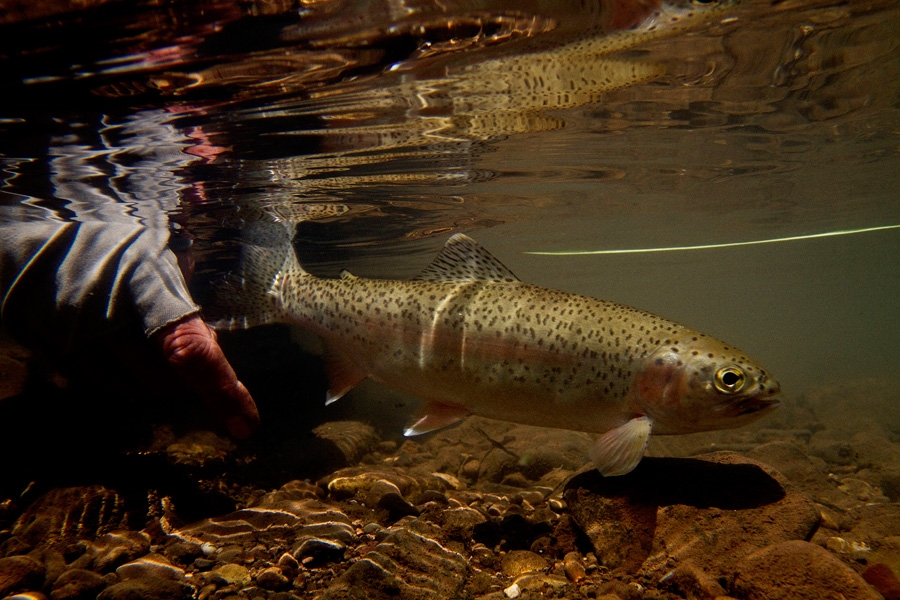Text and images Tom Sutcliffe
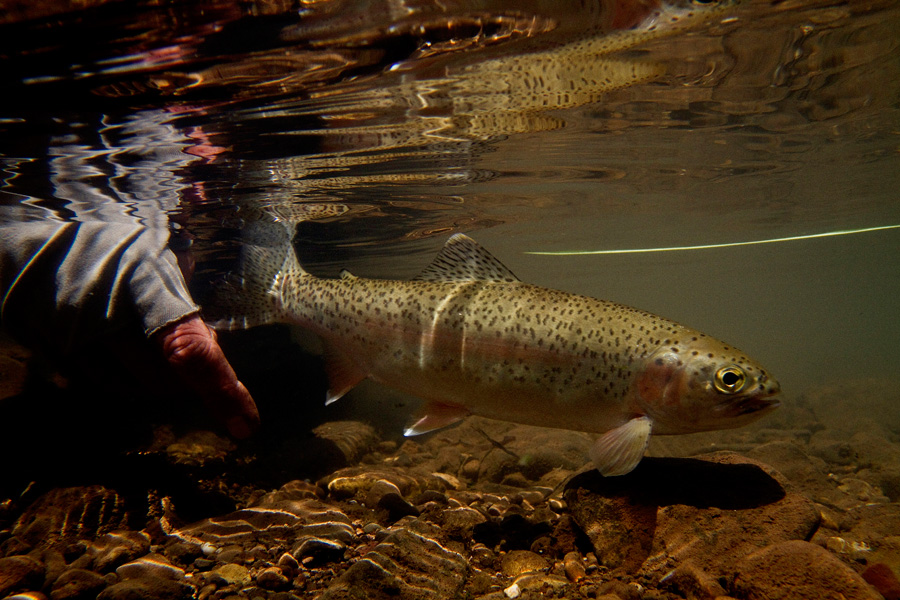
Releasing a Sterkspruit trout
Fishing alone and photography
I occasionally sing the virtues of fishing alone, but I actually don’t really believe much in them. If I have a choice I prefer company on a stream, for the obvious reasons, but also because if my companion happens to have a little fish sense, or better, was actually trained to handle fish for a camera, it helps with my on-stream photography. No, let me put that differently. It’s essential for on-stream photography.
Some people can handle fish for a camera, some can’t. Some do it instinctively; others just never get the thread no matter what. Give them a fish and they want to lift it as far out of the water as they can, or hold it at a weird angle to the camera, or they clutch the fish so tightly the photos end up looking like someone trying hard to throttle a fish.
The best I ever knew was Billy de Jong. He is a born fish whisperer, full stop. Since we started taking our photography seriously back in 2005, Billy and I have put in hundreds of hours together behind cameras on streams, if not a few thousand.
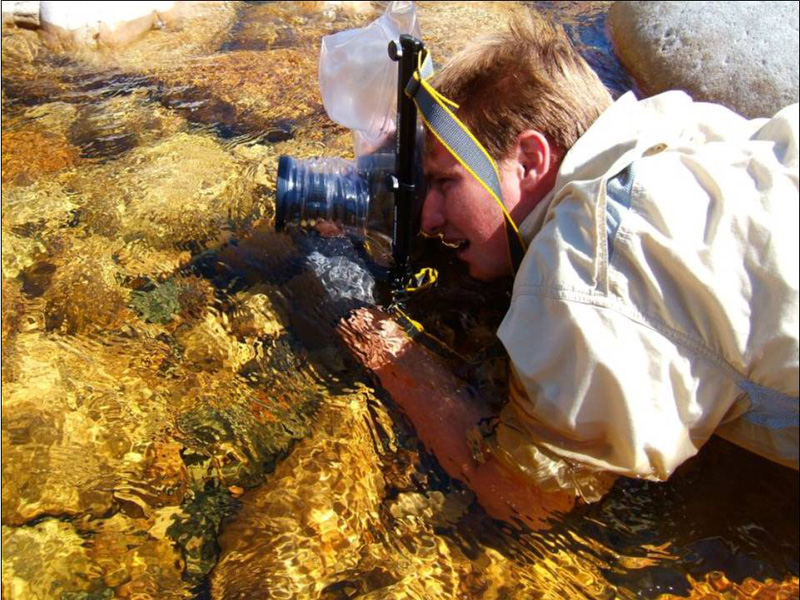
Billy de Jong
But let me get to the point. I found myself on Birkhall without much more to do than tie flies, download photographs, clean the worst of the muck out of my truck and go fishing – alone.
The day was pleasant with a few scattered clouds trailing long wisps like whipped meringue and the wind did no more than tug at my shirt. The Sterkspruit was looking pretty, running with a lovely turquoise-tinted opalescence, alook it gets when things are about just right.
I got in well below the Tank pool on Birkhall and fished up the river for half a mile, catching trout from most of the likely spots, and in the most likely ways, meaning on a range of buggy looking dry flies, or on weighted nymphs drifting under indicators, the fish mostly taking the fly in the seams of current closest to the riverbank.
I had come back to the Tank section because, a few days before, I moved what seemed a really good fish here. It was lying in a basin of slack water under a willow and it seemed that good a fish I wanted to prove I hadn’t been hallucinating. I dropped a Zak in right spot and straight away the leader drew under like a snake down a hole. I landed a pretty 10 inch fish that I tried to convince myself couldn’t be the big one I’d raised before, though just how it came to be sitting in exactly the same place was something I couldn’t really answer without coming to the conclusion that some trout can baffle you about how big they really are.
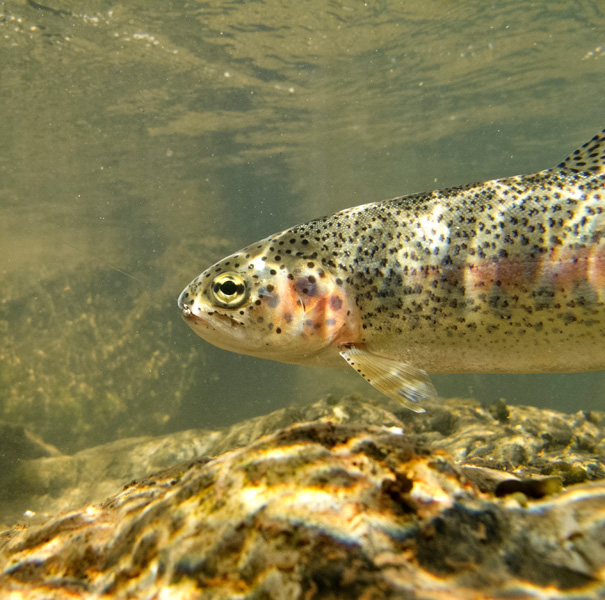
A pretty fish, though, with large lilac spots
It was a pretty fish, though, with large lilac spots on its gill plates. I tried photographing it, but gave up after 20 minutes. Being alone I had to and hold the camera under the water in my right hand, and keep it level, position the fish with the tippet in my other hand, then trigger the shutter at just the right moment while the fish, of course, was darting around like a kite in the wind. It was a juggling act where a heap of variables need to come right at precisely the same instant. I could see the situation heading from frustration to anger, so as a safety precaution I climbed out to cool off, sat under a tree and rotated through the images I’d taken. I found one passable picture in 20. And if I'd only managed to get half the fish in the frame, at least it was the front half.
I slotted the cameras into my backpack and fished the rest of the stretch in peace.
Birnham on the Bokspruit
I spent an afternoon fishing the Bokspruit on Birnham with Tony Kietzman. We met at the Riflespruit T-junction on the back road from Rhodes where he left his truck. While he was slinging his gear across to my cab I noticed the road signs had been replaced. I could tell they were new because they weren’t shot full of bullet holes yet. Then Tony’s favourite cap, the sun-bleached, sweat-rimmed orange one, flew off his head in the wind, which didn’t surprise me because sitting there I could feel my truck rocking under the enormous gusts.
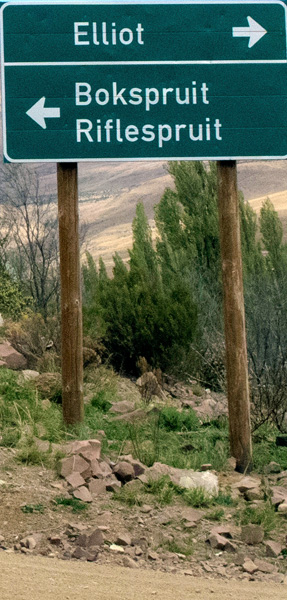
The new sign on the Riflespuit T junction
I’ve known better starts to fishing trips, a day offering us all the excuses we needed to explain why we hadn’t caught a heap of fish when we got back home. The clouds were hanging on the trees, the wind had been howling for five days and was worsening and the barometer was way down. There was little you could easily isolate as a favourable omen. It struck me that an entry level requirement for all serious anglers is to learn to live on the upside of the optimism curve. But at least we were going fishing.
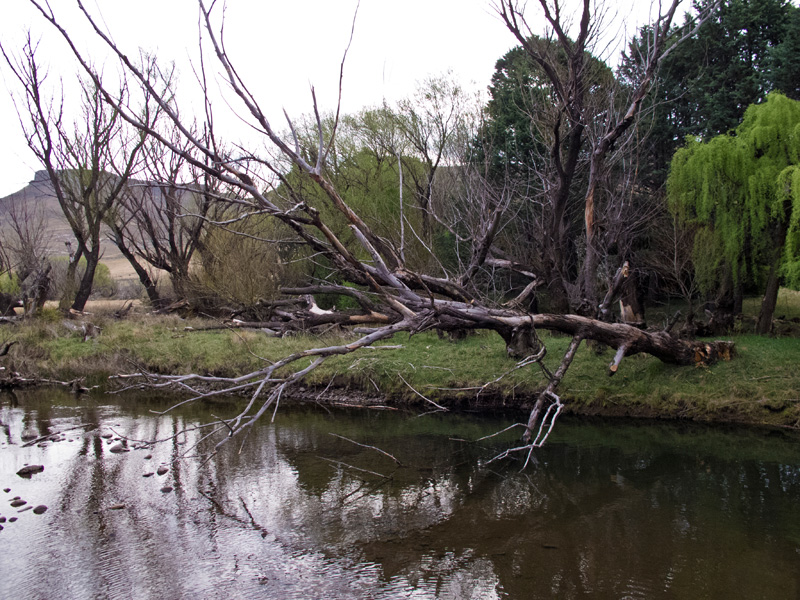
The Bokspruit from the bridge on Welgemoed
We scanned the river from the bridge on Welgemoed. It was clear and flowing well enough to carry a dry fly, but it was low. The willows along the bank were bright green in contrast to the stark remains of the dead crack willow trees that littered the banks at crazy angles. The surrounding veld was black from a recent burn, but already the green shoots of new growth were coming through. Sheep starred vacantly at us from behind fences, along with their lambs that were long-legged and unsteady, still too white to be more than a week old. But as for trout we saw no sign of them at the bridge.
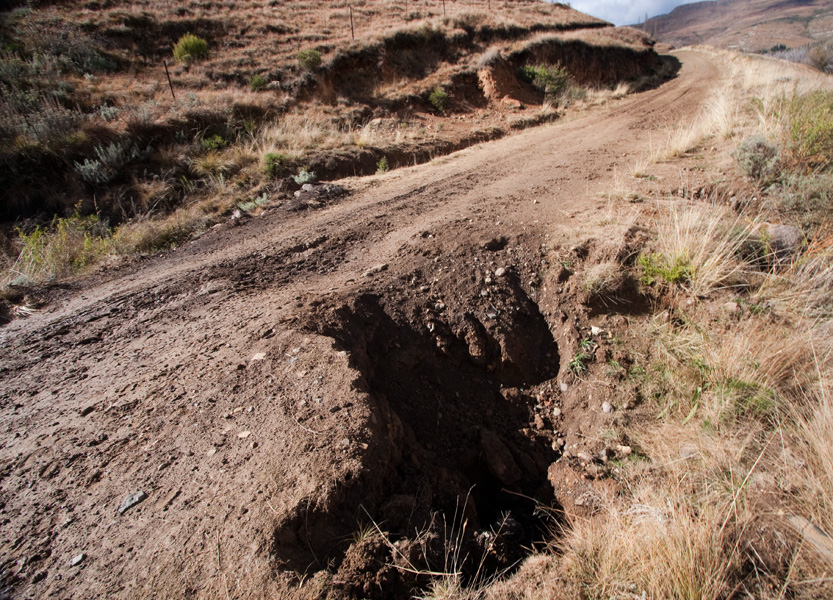
Donga on the Bokspruit road
You need to drive the Bokspruit road carefully these days. It’s a dead quiet road because along the whole route there isn’t a farm still occupied. The homesteads on welgemoed, Roseneath, Knockwarren, Birnham, Brucedell, Belmont, Gateshead are vacant, the farms run by absent owners, or leased out, or used as guest places. So if you break down don’t expect help, at least not inside a few hours. In two places storm water pipes have collapsed, leaving gaping holes that stretch half way across the road.
We parked in a lay-by where a culvert leads you down stepped gabions, under a fence and into the river. The burned grass crunched under our feet. We were surrounded by mountains covered in grey veld that ran up the slopes to steep crags. The river valley here is striking in its own way, the vegetation sparse, scrubby and low growing. There are patches of poplar in places along the river with pale, grey green leaves this time of year and like the willows they were dancing in the wind. It’s lovely, remote country where we normally see buck or high soaring raptors and even if we saw none on the day, we had the feeling they were watching us.
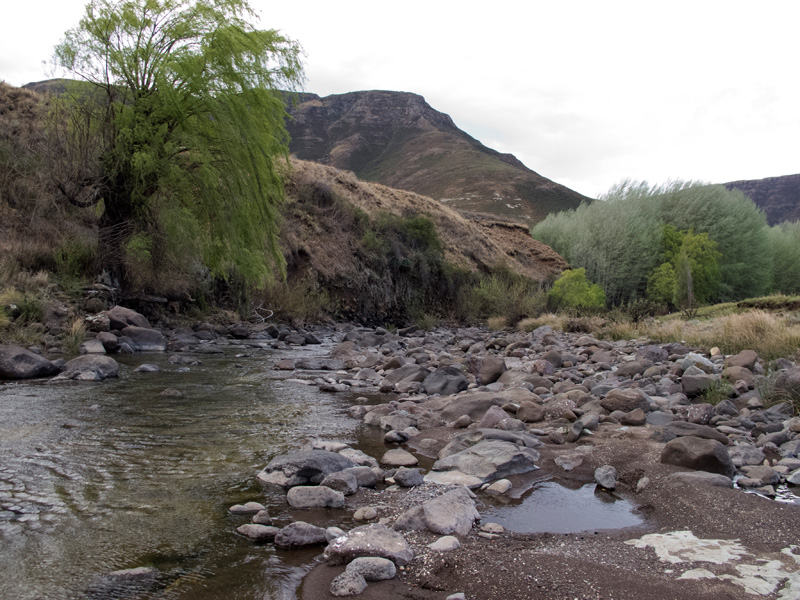
The shallow sandstone bed runs on Birnham. Notice the poplars dancing
The runs immediately below the culvert are deep and quick, but a little further on, the stream flows for a few hundred metres over sheets of sandstone where the water can’t be more than a foot deep and takes on a turquoise tint. I suspect most people don’t fish this piece because they won’t easily recognise any holding water here, but there are always fish in these shallow runs, just living off whatever comes by in the drift, the odd hatch, or the occasional terrestrial that drops in. They seem to survive well enough, though you won’t find any of them in the record books.
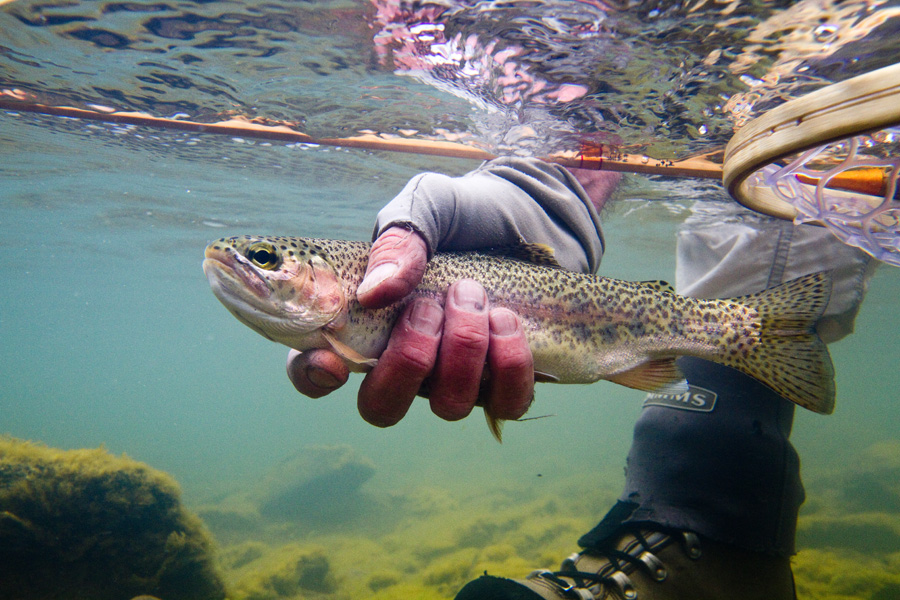
Small rainbow from the shallow runs and at the moment of release

I shrugged into a fleece shirt and pulled on a wind breaker. Tony discovered he’d clean forgotten to fetch his cap after it blew off his head. I loaned him a spare I carry. The air was cold and the wind hit us like nails. Occasionally we felt a raindrop, but it never got worse than that, even though we expected sleet any moment. We had no real hopes of seeing a rise, but in one of those minor wonders of nature for which there’s no obvious explanation, fish did occasionally rise, some even tried to swallow our dry flies, a few got it right, and some we landed on the strike, meaning they were that small they ended up flying out of the water and dropping at our feet. Those were all of four inches long.
We fished up to the avenue of polar trees that begins where the bedrock ends, saw no more fish, not even little ones, by when we were asking ourselves what the point of being out here actually was, without saying so in as many words.
We headed back to fish the runs where we’d climbed in. The cloud cover broke a little and from brief moments weak sunlight flooded the valley.
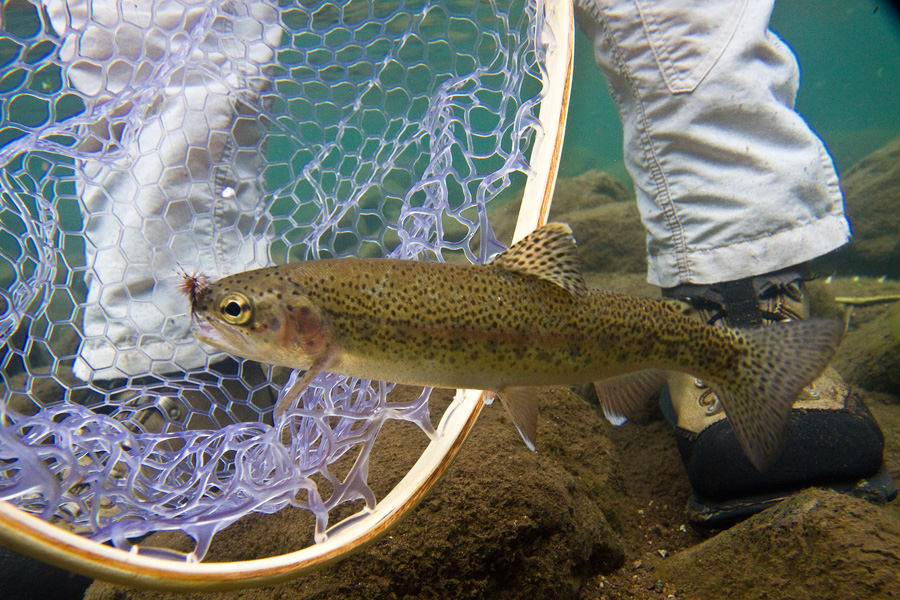
A decent-sized Birnham rainbow. Note the turquoise tint to the water
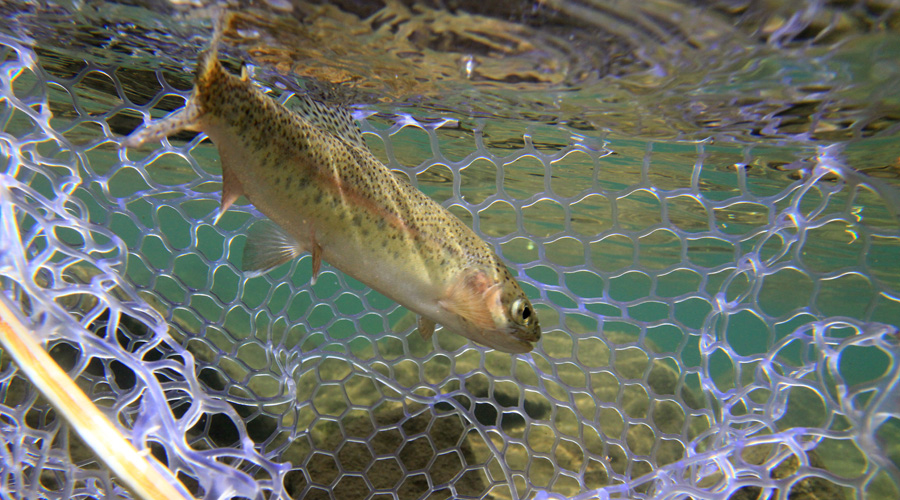
We landed a few fish on dry flies and even managed some underwater shots, but by now the wind was so strong the odd gust threatened to topple us. I found myself ducking instinctively on the forward cast to prevent getting a hook in the ear and even tying knots was a struggle because the tag ends kept blowing into the wrong places.
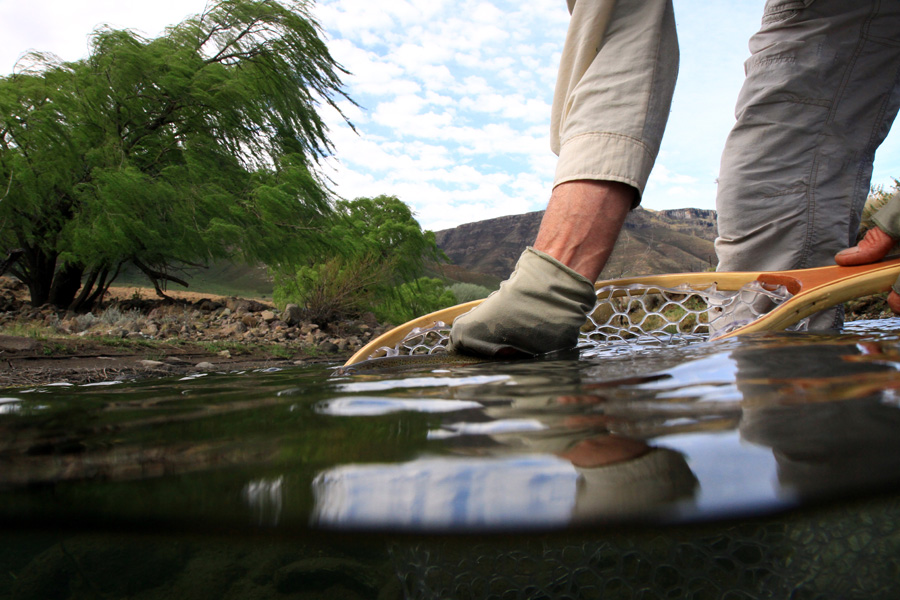
Note the wind dragging the poplars
At some point we were overcome by a sudden wave of sensibleness and headed back to the truck.
We decided to change out of our gear on the bridge at Welgemoed. A bridge is a handy place to stop on when you can. There’s less dirt under your feet and you can watch the water at the same time, which lends a sense of usefulness to that otherwise tedious business of getting out of your wet boots and packing up fly rods.
The bridge can only take one car at a time, but we reckoned in that part of the world it would be a few hours before another car came along – if any came along at all. We dropped the tailgate, brewed coffee in a kettle of river water, found cream crackers and a slab of cheese, opened a can of baked beans and dug out the last of a bottle of Muscadel.
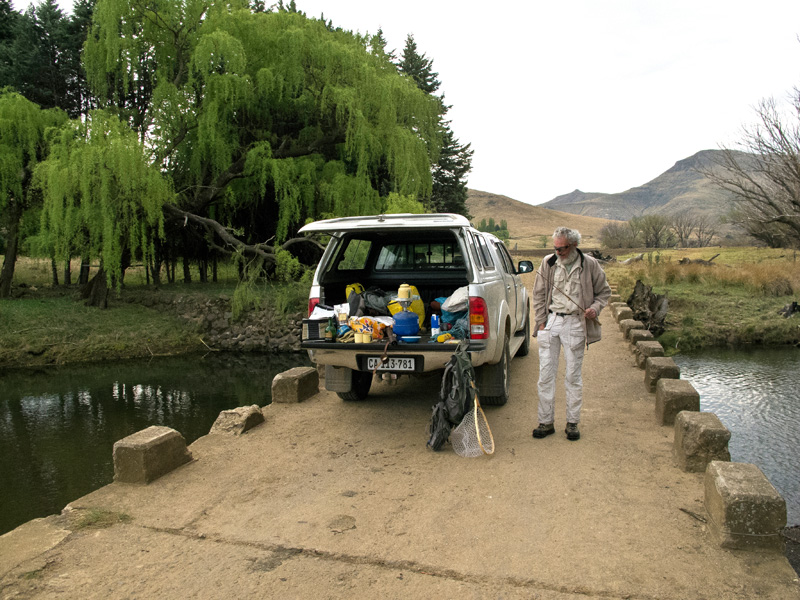
The bridge can only take one car at a time
It was around 5.30 and we were just enjoying the comfort of our dry clothes and the pleasures of a late riverside snack when a battered taxi arrived wheezing on the bridge. It was probably the only vehicle to travel the road since we had. We cursed our luck, threw scattered bits of wet gear into the cab and inched the truck forward until the driver had enough space to get his passengers through. Naturally we resented his arrival. The bridge had got to feel a lot like our own space by then.
I dropped Tony at his truck. Fortunately his cap had wedged itself against a big tuft of grass right alongside his vehicle and despite the wind it had stayed there all afternoon.
The Sterkspruit on Birkhall
My last day of this trip was on the Sterkspruit and I can easily describe it in one word – perfect. The river was in good shape and the trout were bigger and fatter than they had been for years.
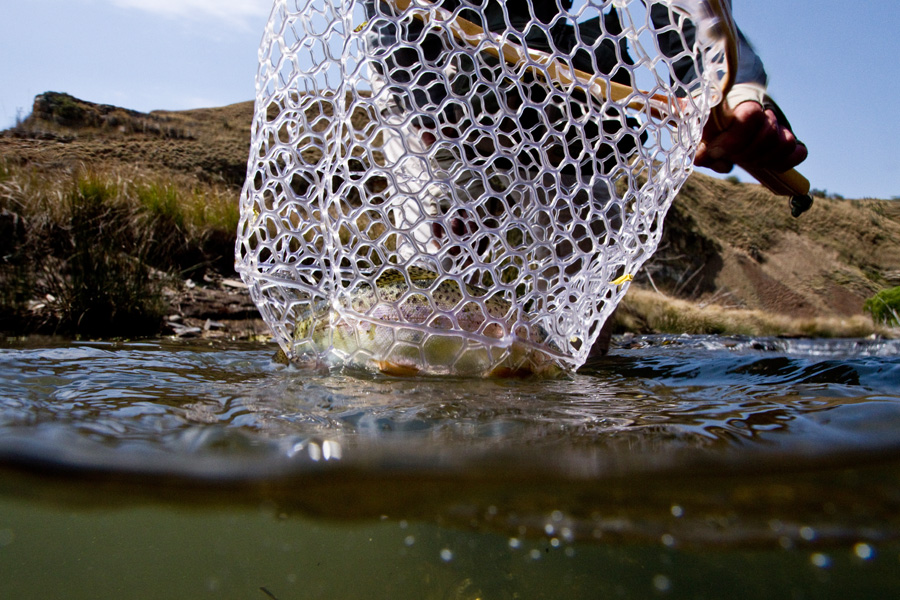
Deeper and fatter fish than ever before
Tony joined me and we dusted a series of shallow runs with Coq de Leon halo-hackle Para-RAB dry flies and raised and hooked trout in all of them. Basie joined us for a short while, a rare privilege. He managed to hook a few trout on a Mirage dry fly, which pleased him, then tried to fool a couple of big yellowfish in a basin of deep water, but they weren’t interested.
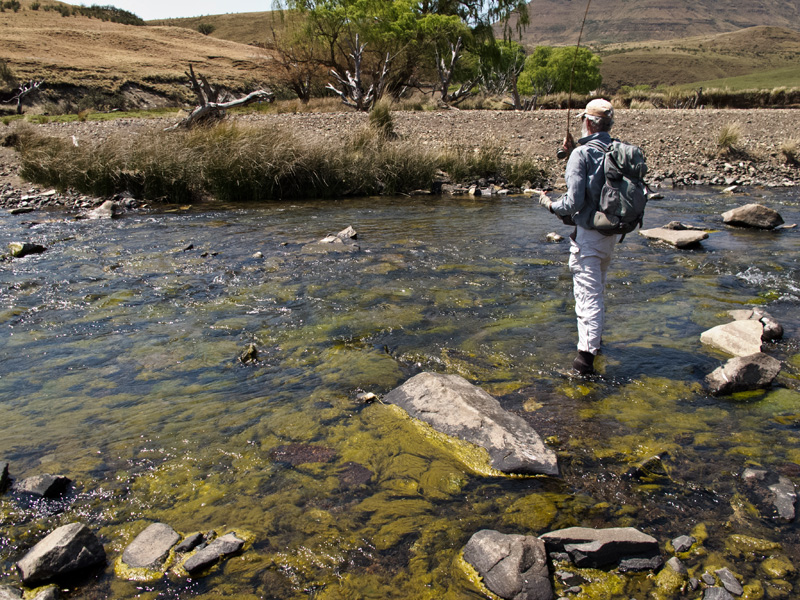
Thin runs on the Sterkspruit were full of fish
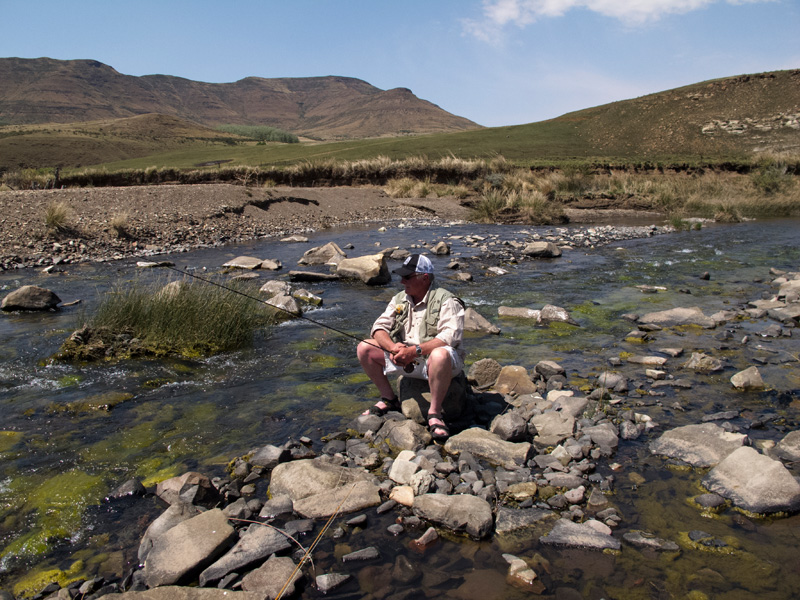
Basie Vosloo, owner of Birkhall
The Para-RAB was turning out to be some fly. It’s not far off a few very similar South African parachute-type dry fly patterns with a halo of hackle, hair or pheasant centre tail fibres, some of which go under the name of spiders or ants. Most have a post as a sighter and a parachute hackle, mainly genetic brown or grizzly, over wound with a few turns of whatever the halo is made from. To my way of thinking Coq de Leon hackle can’t be beaten, but Philip Meyer designed the first Para-RABs using a squirrel hair ‘halo’ and Fred Steynberg, Pete Briggs and Tim Rolston, among many others no doubt, each have their own take on roughly the same kind of fly.
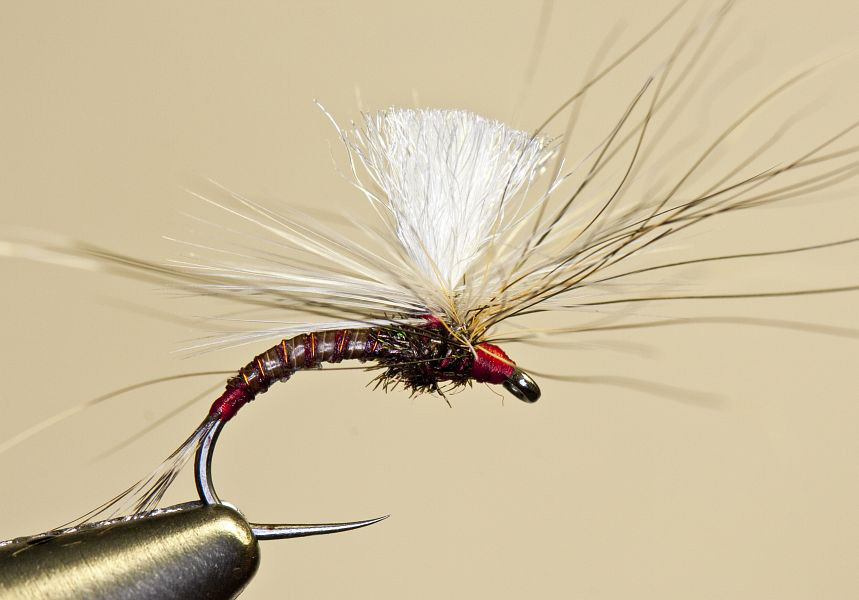
Philip Meyer's version of the Parachute RAB
We also took fish on nymphs, including Zaks with beads, Hare’s Ears and MC Coetzer’s CDC and Squirrel Nymph with a bright orange wing case that in learned circles we now call a ‘hot spot’, a product of English stillwater fly fishers originally, but as much a product I suspect, also of modern European schools of nymphing, particularly French and Czech styles.
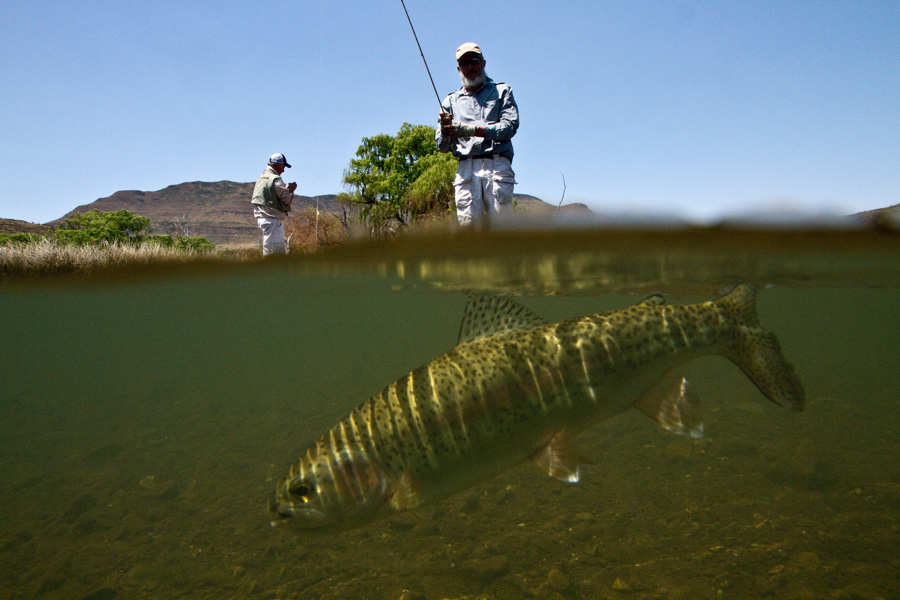
Basie in the background while Tony plays a fish
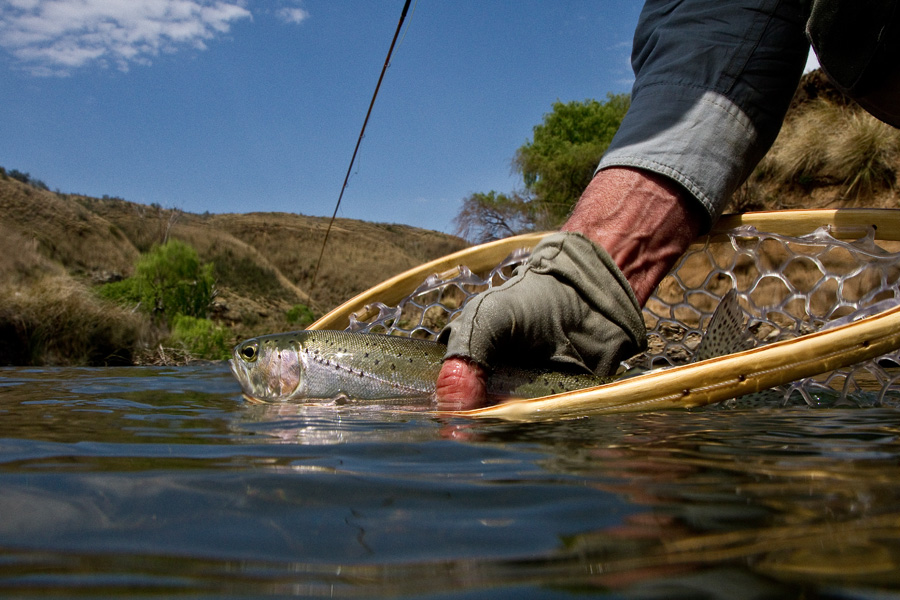
Sterkspruit landscape
We stuck with the dry fly because its prettier fishing, but the moment things went slow, or if a dry fly repeatedly failed to produce in a run, we drifted a nymph through the water, at first dead drift and if there was no interest, later with a little movement. If you bundle up this progression of fishing strategies it probably represents a sensible approach to all rivers in the area at any point in the season. That would be outside of using attractors, of course, like Mrs Simpson’s or Woolly Buggers, fished on a deep retrieve with sinking lines, something that wouldn’t interest me even if I knew it would catch me some trout. If that sounds pretentious it’s not meant to be.
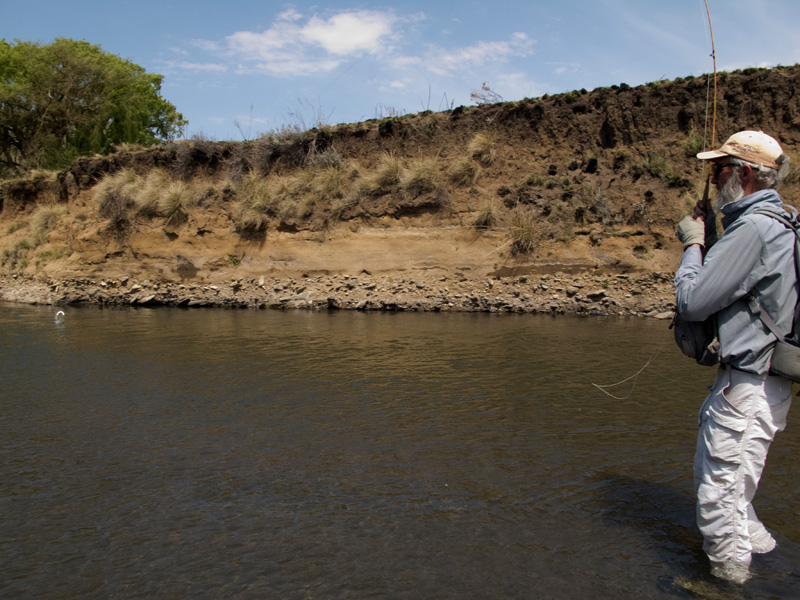
The fishing was hot and the weather idyllic
By the time we had fished back to where the truck was parked we had worked out that the fishing was hot, the weather was idyllic, the stream was lovely and we shouldn’t stress about getting back in time for lunch. Tony dropped like a stone in a patch of shade and was briefly asleep. I spun through some pictures on my cameras and rigged a whole new leader.
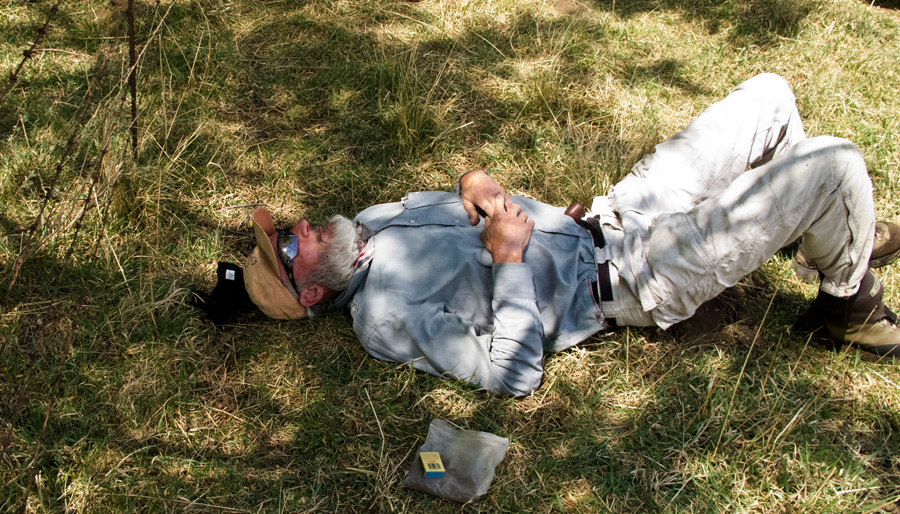
Tony Kietzman meditating
Getting back to the idea of a bundle of strategies to suit any trout stream hereabouts, let me add we were both on bamboo rods, mine a 7 ft 4-weight Dugmore and Tony was glued to my ultra-light Dugmore as usual. Both were perfect tools for the day and had the added advantages of casting well and looking good. I did a quick mental check and found that over the past 14 day’s fishing I had only used bamboo rods, my Boshoff and my Dugmore, both 4 weights and both as pretty as a mountain stream.
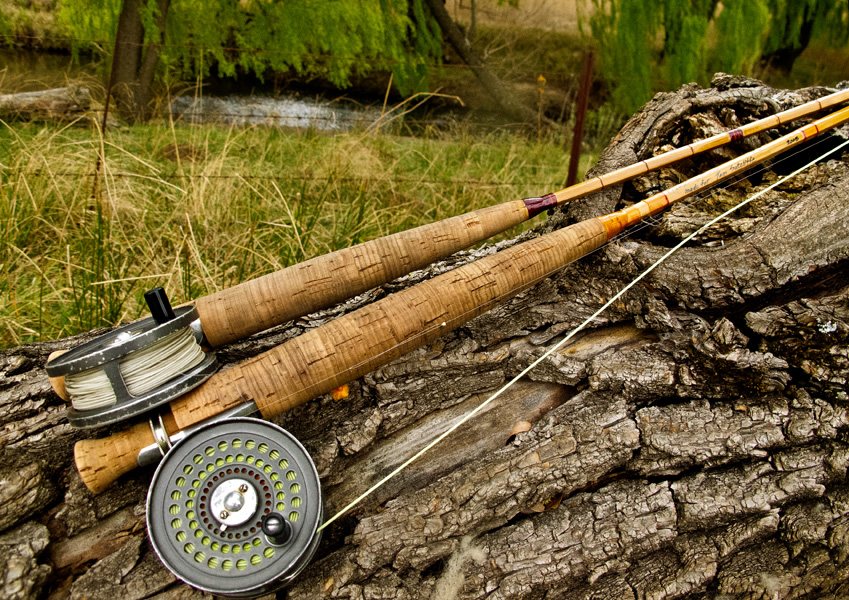
A pretty brace of Dugmore bamboo rods
Leaders were 9 feet tapered and tippets ranged from 3 to maybe 6 feet maximum, nearly always 6 X unless we had some compelling reason to go lighter, as in the upper Coldbrook, or heavier, as with those big yellows in the lower Sterkspruit. Generally I was using nymphs one size smaller on this trip, #16 as opposed to #14, and the same goes for the dry flies. They just seemed to work better. Then for some reason not located firmly in science but more in personal preference, I fished New Zealand rigs less than I normally do and had easier casting, less tangles and better drifts, for it.
Strike indicators never changed. I stayed the orange Glo Bug yarn treated with Loon’s floatant and attached with the Frontier’s remarkably effective indicator threader developed by The Strike Indicator Company in New Zealand.
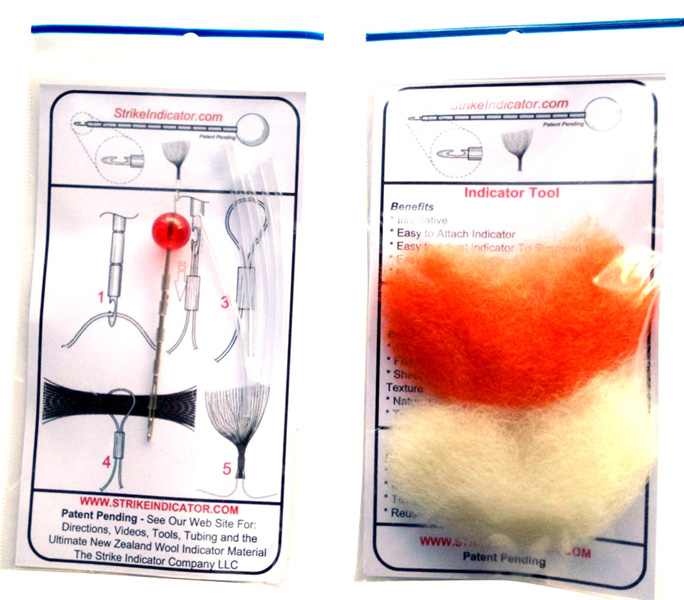
The Strike Indicator Company threader
Overall, you could say the formula was simple, uncluttered and effective.
The afternoon’s fishing was as good as we expected, although the sun slid behind a bank of clouds and the bright-water sheen of the morning left the day. Orange yarn indicators showed up better in the half light and the fishing was easier for it. For the first time the water felt cold and I had a feeling the wind would get up again just about when it did. It was blowing upstream and straightening our casts.
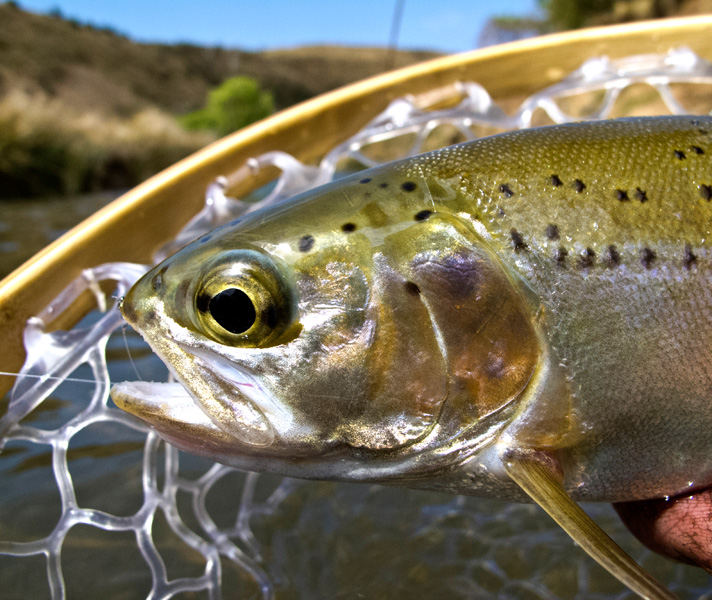
Rainbow with beautifully discrete markings and its release
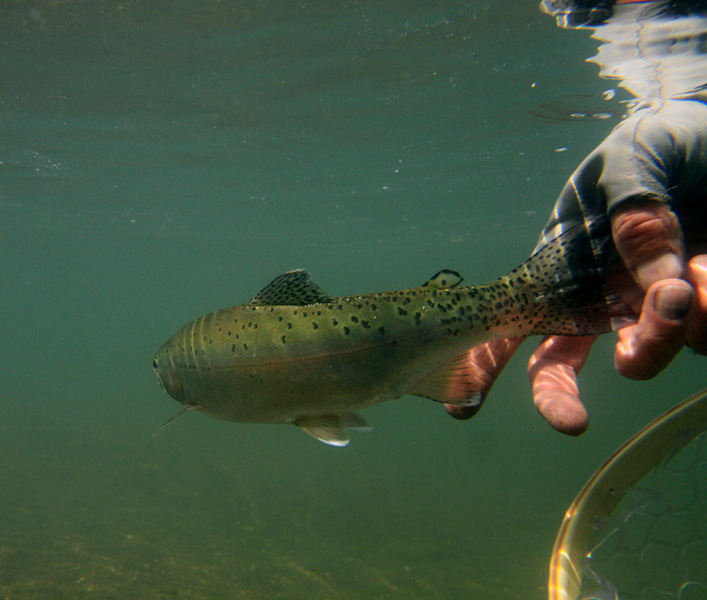
As I said, the fish were fatter and deeper than I have known them for years, some discreetly marked, like cutthroats, others like made up cabaret artists with lilac and blue spots sprinkled across their gill plates. I guess thinking back on the trip, we had plenty of 14 inch trout and a few that would have gone 15, some even 16 inches, though I am not wrapped up in the exact size of a fish, just know a decent sized fish when I see it. And yes for those into exact reporting and the absolute truth, even bigger trout have been taken in these parts, but as Ed Zern once said on the subject of measuring trout and reporting honestly, ‘I get all the truth I need from the newspapers every morning. I go fishing to get the taste of it out of my mouth.’
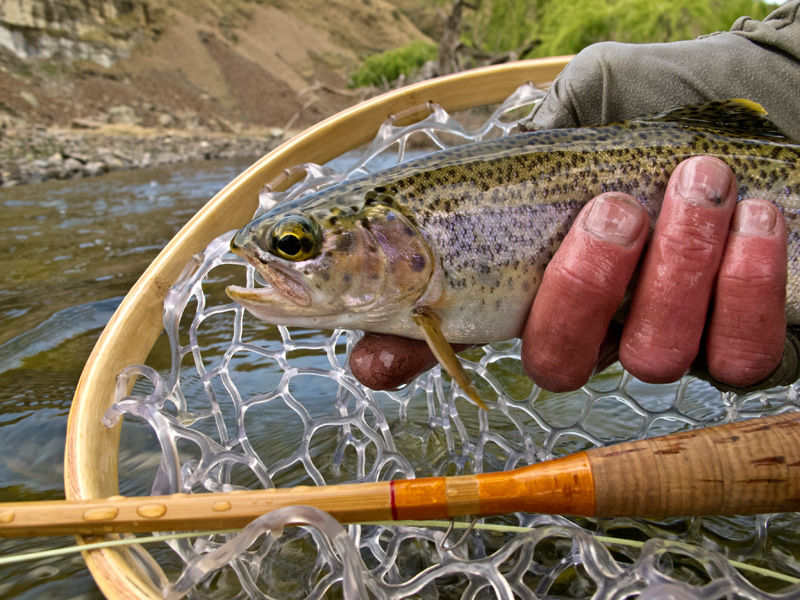
Lilac and blue spots sprinkled across their gill plates
One fish I spooned had been eating hard from the number of insects we counted in its stomach, around 100, a real aquatic soup. Another had a few flying insects in it that we thought were maybe Lacewings or adult Sawflies. Later I found an adult sawfly on my hand. There were bugs around all day, but there was never what you would call a real hatch.
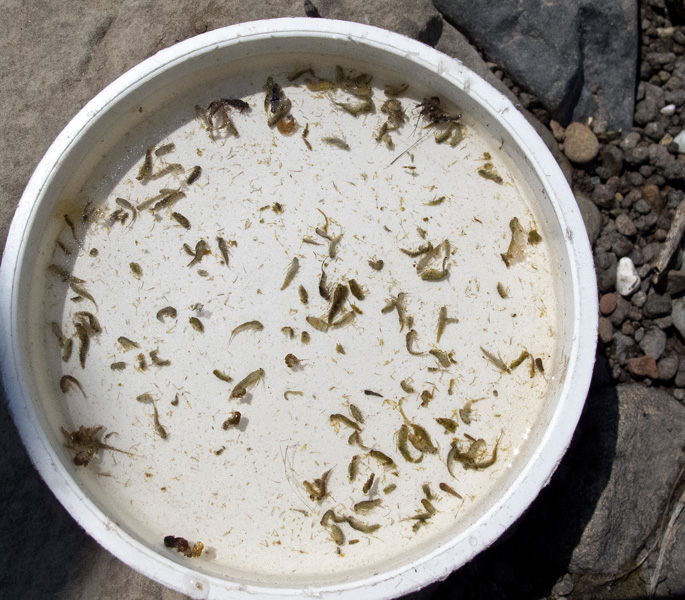
The aquatic soup
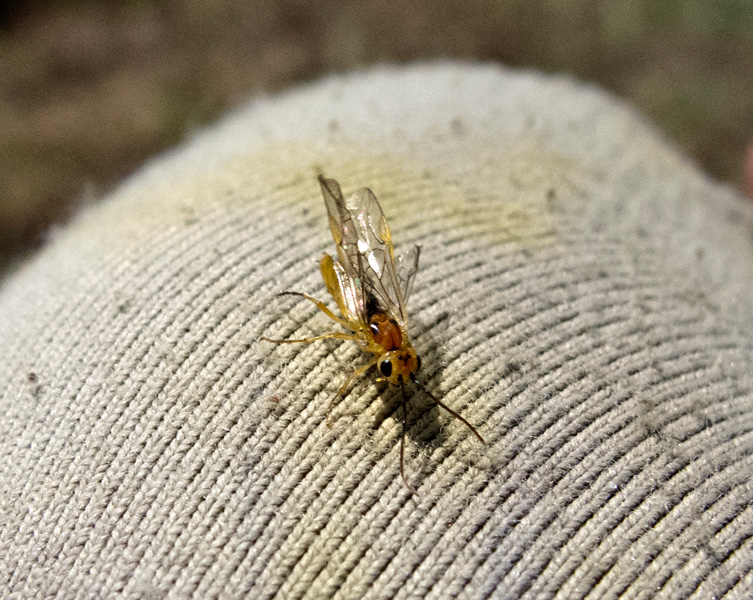
Sawfly adult
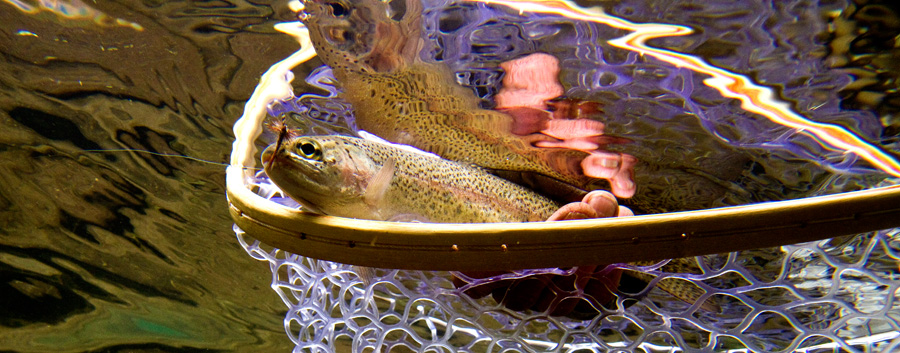
We were home on Birkhall by 4.00, well in time for Sunday lunch. Mike McKeown and Tom Lewin of Frontier Fly Fishing were waiting for us on the veranda. They had just travelled down from Joburg and still had the bright-eyed, excited kid look that city folk get when they are newly arrived in a remote backcountry fishing place. They were planning to spend a day up at Gateshead and a day on the Kraai, then head off to Highland Lodge to catch a few stillwater trout. I was tempted to join them, but my domestic exit visa was all but expired so I thought better of it. We swallowed a few beers together and talked water conditions, bamboo rods, fly patterns that were working and in the end I parted with my remaining Para RABs and a few yellow DDDs that I thought might come in handy for them at Gateshead.
In time we sat down to a late Sunday lunch with Basie and Carien, all of us around their large dining room table, where Mike discovered the joys of Carien’s homemade horseradish sauce and just how good the local beef is.
Somewhere on my drive home two days later, probably in the deep Karoo, I heard that Tom and Mike had a good day on Gateshead. I wouldn’t have expected any different, but it was sort of irrelevant anyway, because even a bad day at Gateshead beats a prime day in the city.
***
This was a longish stay on Birkhall and as usual Basie and Carien made me feel like I am part of their family, not just another trout bum bearing rods and seeking protracted shelter. Wonderful people and the kindest friends. We worked out it’s been 17 years since I first invaded their place.
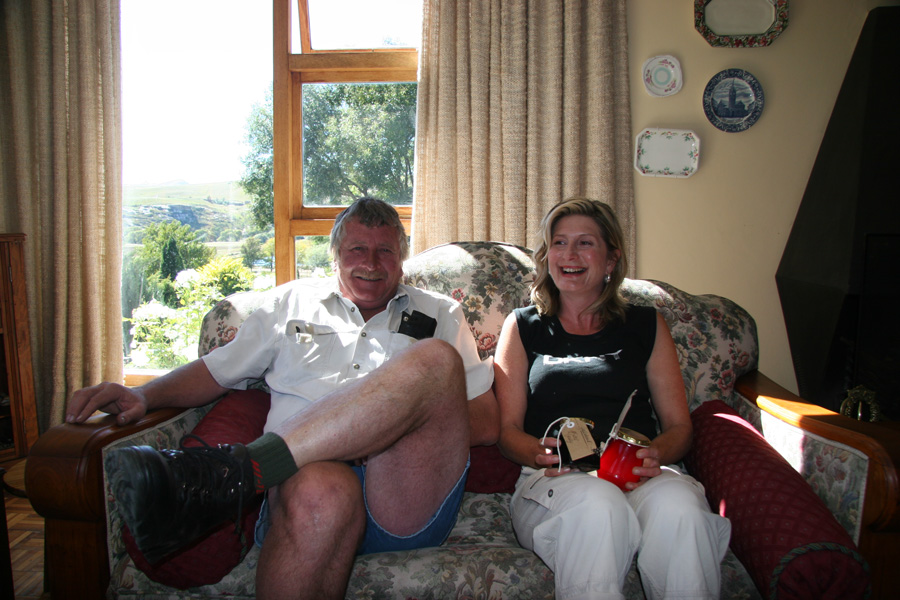
The Vosloos on Birkhall
As usual Tony Kietzman put himself out being company on the fly stream. Look, I know he hates it, but what a good man he is and a great friend to have.
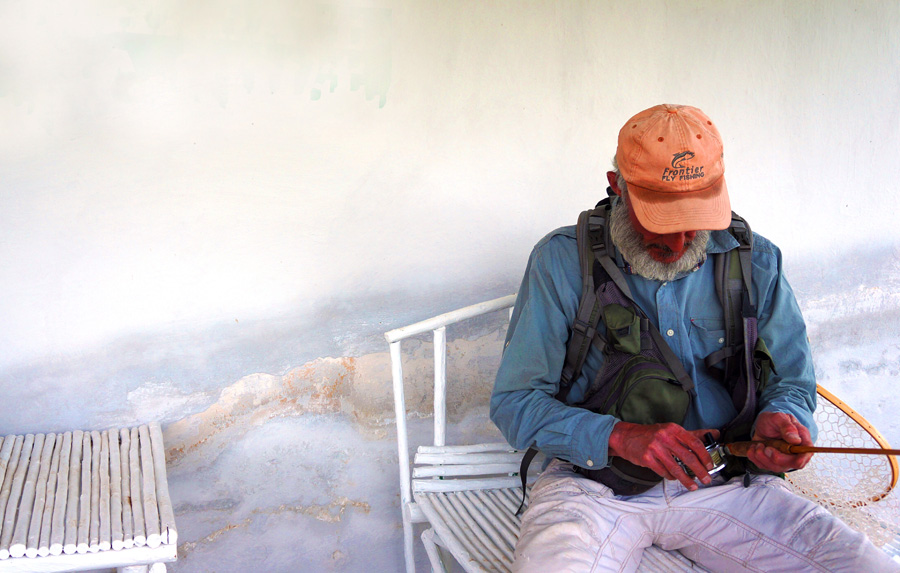
Tony contemplating a pretty Homer Jennings bamboo
Tom Sutcliffe

